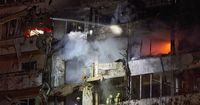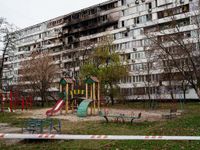On Tuesday, November 25, 2025, the Russia-Ukraine war entered yet another harrowing chapter, with both nations unleashing massive overnight drone and missile barrages that left dozens dead and wounded, and heightened the urgency of ongoing peace negotiations led by the United States. The violence came just hours before American, Ukrainian, and Russian officials gathered in Abu Dhabi and Geneva to discuss a new, controversial proposal aimed at ending a conflict that has dragged on for nearly four years.
The scale of the overnight attacks was staggering. According to Ukrainian President Volodymyr Zelensky, Moscow fired 460 drones and 22 missiles at Ukraine, targeting Kyiv and several other regions. The strikes killed at least seven people and wounded 21, with the capital suffering extensive damage to residential buildings and civilian infrastructure. "The main Russian attack overnight targeted the capital and the region, causing extensive damage to residential buildings and civilian infrastructure across the city," Zelensky wrote on X. Water, electricity, and heating services were knocked out in large swathes of Kyiv—an especially cruel blow as winter sets in. At least one major energy facility was hit, leaving six people wounded, including two children, according to Ukraine’s energy ministry. The ministry also reported that more than 102,000 people across five regions lost power due to the assault.
The Black Sea port city of Odessa was not spared, with port and energy facilities damaged and six people injured. The attack’s reach was so broad that NATO scrambled jets after Russian drones reportedly entered Romanian airspace—the farthest such incursion since the war began. At least six drones also crossed into neighboring Moldova, raising alarms in a country that is not a NATO member, as reported by local authorities.
Ukraine responded with force, launching what the Russian Ministry of Defense described as the fourth-largest drone attack of the war. More than 249 Ukrainian UAVs crossed the border overnight, striking deep into Russian territory. The city of Taganrog in Russia’s Rostov region was hit particularly hard; regional Governor Yuri Slyusar confirmed at least three people were killed and eight injured. Ukrainian drones also targeted high-value infrastructure, including an aviation repair plant, a drone production facility, an oil refinery, and an oil terminal—sites seen as vital to Russia’s ongoing war effort.
As the violence escalated, diplomatic efforts continued in parallel. President Donald Trump, at the center of the U.S.-led peace initiative, said Tuesday his plan to end the war had been “fine-tuned.” He announced he would send special envoy Steve Witkoff to Moscow to meet with Russian President Vladimir Putin, and Army Secretary Dan Driscoll to Ukraine for talks with Zelensky and other officials. Trump suggested he might meet personally with both Putin and Zelensky, but only if the deal was in its final stages. “I look forward to hopefully meeting with President Zelenskyy and President Putin soon, but ONLY when the deal to end this War is FINAL or, in its final stages,” Trump wrote on social media.
Trump’s peace plan, which initially consisted of 28 points and was presented to Ukraine the previous week, has been at the heart of recent negotiations. The proposal heavily favored Russia in its original form, calling for Ukraine to concede the entirety of its eastern Donbas region—an area where much territory remains under Ukrainian control. Trump played down the cession, suggesting that, “The way it’s going, if you look, it’s just moving in one direction. So eventually that’s land that over the next couple of months might be gotten by Russia anyway.” However, analysts at the Institute for the Study of War have estimated that it would take several years for Russian forces to fully seize Donbas at their current rate of advance.
The peace plan has been a moving target, with amendments and reductions in the number of points following negotiations between Ukraine and the Trump administration over the weekend. Ukrainian delegate Oleksandr Bevz told the Associated Press that the document had been reduced to remove duplicates and points unrelated to Ukraine, but he denied reports that the plan had been cut to 19 points. “(The document) is going to continue to change. We can confirm that it was reduced to take out points not relating to Ukraine, to exclude duplicates and for editing purposes,” Bevz said. He also emphasized that the strength of security guarantees for Ukraine would “define the sustainability of the deal” and was “the part making this deal real and enforceable.”
European leaders have watched the process with a mixture of optimism and concern. French President Emmanuel Macron described the peace efforts as being at “a crucial juncture,” while European Commission President Ursula von der Leyen said the latest coalition meeting of Ukraine’s allies showed “solid and encouraging progress.” British Prime Minister Keir Starmer added, “I do think we are moving in a positive direction and indications today that in large part the majority of the text, (Zelenskyy) is indicating, can be accepted.” Yet, as Oleksandr Bevz cautioned, “it was very premature to say that something is agreed upon.”
Russian officials have been more reserved. Foreign Minister Sergey Lavrov stated that Moscow was waiting for the United States to submit an “interim” version of the modified plan. He warned that if the plan erased what he called “the spirit and letter of Anchorage”—a reference to an August meeting in Alaska where Trump sided with Russia’s approach to ending the conflict—then “it will be a fundamentally different situation,” signaling resistance to any significant rollback of Russia’s maximalist positions.
The human toll of the conflict remains front and center. Images from Kyiv showed a large fire engulfing a nine-story residential building in the Dniprovskyi district, and Mayor Vitalii Klitschko reported 20 wounded in the city. Liubov Petrivna, a 90-year-old resident of a damaged building, told the Associated Press, “Absolutely everything in my apartment was shattered by the strike and glass rained down on me.” She expressed deep skepticism about the peace plan, saying, “No one will ever do anything about it. [Putin] won’t stop until he finishes us off.”
As the world watches and waits, the coming days will test whether the momentum behind these fraught negotiations can overcome the bitterness and devastation of war. For now, both the violence and the diplomacy continue, each shaping the fate of millions caught in the crossfire.


